Performance Analysis of Real-Scale 23 kV/60 MVA Class Tri-Axial HTS Power Cable for Real-Grid Application in Korea
Abstract
1. Introduction
2. Design of a Tri-Axial HTS Power Cable
2.1. Numerical Design of the Tri-Axial HTS Power Cable
2.2. FEM Anaysis of the Tri-Axial HTS Power Cable
3. Measurement Results and Discussion
4. Conclusions
Author Contributions
Funding
Conflicts of Interest
References
- Li, Z.; Ryu, K.; Fukui, S.; Hwang, S.D.; Cha, G. AC Loss Measurement of a Short HTS Cable With Shield by Electrical Method. IEEE Trans. Appl. Supercond. 2011, 21, 1005–1008. [Google Scholar] [CrossRef]
- Lee, S.J.; Park, M.; Yu, I.K.; Won, Y.; Kwak, Y.; Lee, C. Recent Status and Progress on HTS Cables for AC and DC Power Transmission in Korea. IEEE Trans. Appl. Supercond. 2018, 28, 5401205. [Google Scholar] [CrossRef]
- Sytnikov, V.; Shutov, K.; Polyakova, N.; Fetisov, S.; Nosov, A.; Vysotsky, V. The AC Loss Analysis in the 5 m HTS Power Cables. IEEE Trans. Appl. Supercond. 2009, 19, 1706–1709. [Google Scholar] [CrossRef]
- Satoshi, F.; Takeshi, N.; Jun, O.; Mitsugi, Y.; Takao, S.; Osami, T. Analysis of AC Loss and Current Distribution Characteristics of Multi-Layer Triaxial HTS Cable for 3-Phase AC Power Transmission. IEEE Trans. Appl. Supercond. 2006, 16, 135–138. [Google Scholar]
- Hamajima, T.; Tsuda, M.; Yagai, T.; Monma, S.; Satoh, H.; Shimoyama, K. Analysis of AC Losses in a Tri-axial Superconducting Cable. IEEE Trans. Appl. Supercond. 2007, 17, 1692–1695. [Google Scholar] [CrossRef]
- Rabbers, J.J.; ten Haken, B.; ten Kate, H.H. Advanced ac loss measurement methods for high-temperature superconducting tapes. Rev. Sci. Instrum. 2001, 72, 2365–2373. [Google Scholar] [CrossRef]
- Zhu, J.; Zhang, Z.; Zhang, H.; Zhang, M.; Qiu, M.; Yuan, W. Electric Measurement of the Critical Current, AC Loss, and Current Distribution of a Prototype HTS Cable. IEEE Trans. Appl. Supercond. 2014, 24, 9500104. [Google Scholar] [CrossRef]
- Nassi, M. HTS prototype for power transmission cables: Recent results and future programmes. Supercond. Sci. Technol. 2000, 13, 460–463. [Google Scholar] [CrossRef]
- Lim, S.-H.; Yim, S.-W.; Hwang, S.-D.; Han, B.-S. Influence of pitch length and winding direction on four-layer HTSC power transmission cable with a shield Layer. IEEE Trans. Appl. Supercond. 2005, 15, 1735–1738. [Google Scholar] [CrossRef]
- Kim, S.; Sim, K.; Cho, J.; Jang, H.M.; Park, M. AC Loss Analysis of HTS Power CableWith RABiTS Coated Conductor. IEEE Trans. Appl. Supercond. 2010, 20, 2130–2133. [Google Scholar]
- Shinichi, M.; Naoyuki, A.; Kazuo, W.; Yasuhiro, I.; Nobuhiro, M.; Takao, M.; Toshiya, M.; Masayoshi, O.; Tetsutaro, N.; Kiyoshi, Y. Study on AC loss measurements of HTS power cable for standardizing. IOPsci. J. Phys. Conf. Ser. 2017, 897, 012021. [Google Scholar]
- Kim, J.H.; Kim, C.H.; Iyyani, G.; Kvitkovic, J.; Pamidi, S. Transport AC Loss Measurements in Superconducting Coils. IEEE Trans. Appl. Supercond. 2011, 21, 3269–3272. [Google Scholar] [CrossRef]
- Steffen, E.; Eduard, D.; Bruno, D.; Francesco, G.; Andrej, K.; Mark, S.; Severin, S.; Victor, Z.; Wilfried, G. New Experimental Method for Investigating AC Losses in Concentric HTS Power Cables. IEEE Trans. Appl. Supercond. 2015, 25, 5900105. [Google Scholar]
- Kazuhisa, A.; Hiroki, O.; Ryusuke, H.; Shigeki, S.; Kei, S.; Nobuhiro, M.; Tsutomu, K.; Takayo, H.; Masayuki, K.; Masataka, I. Design of 22-kV 10-kA HTS Triaxial Superconducting Bus. IEEE Trans. Appl. Supercond. 2016, 26, 5400604. [Google Scholar]
- Ashworth, S.P.; Nguyen, D.N. The electrical measurement of AC losses in a three-phase tri-axial superconducting cable. IOPsci. Supercond. Sci. Technol. 2010, 23, 095009. [Google Scholar] [CrossRef]
- Daisuke, M.; Naoki, T.; Norio, T. AC Loss Reduction of Coaxial Multi-Layer HTS Cable. IEEE Trans. Appl. Supercond. 2011, 21, 991–995. [Google Scholar]
- Tsuda, M.; Fujimoto, J.; Harada, N.; Hamajima, T. Thermal Analysis of Co-Axial Multi-Layered BSCCO HTS Power Cable. IEEE Trans. Appl. Supercond. 2004, 14, 642–645. [Google Scholar] [CrossRef]
- Tsuda, M.; Fujisawa, T.; Hiraoka, T.; Harada, N.; Yagai, T.; Hamajima, T. The Effective Current and Magnetic Field Distributions for Reducing AC Losses in Coaxial Multi-Layer HTS Transmission Cable. IEEE Trans. Appl. Supercond. 2006, 16, 1594–1597. [Google Scholar] [CrossRef]
- Kim, J.G.; Kim, A.-R.; Kim, D.; Park, M.; Yu, I.-K.; Cho, J.; Sim, K.-D.; Kim, S.; Lee, J.K.; Won, Y.-J. Development of a PSCAD/EMTDC Model Component for AC Loss Characteristic Analysis of HTS Power Cable. IEEE Trans. Appl. Supercond. 2010, 20, 1284–1287. [Google Scholar]
- Doan, A.N.; Stephen, P.A.; Robert, D.; William, C.; Steven, F. Measurements of AC Losses and Current Distribution in Superconducting Cables. IEEE Trans. Appl. Supercond. 2011, 21, 996–1000. [Google Scholar]
- Kazuhisa, A.; Kei, S.; Hideo, S.; Tasuku, K.; Noubuhiro, M.; Takayo, H.; Masayuki, K.; Masataka, I. Sudden short-circuit test of 22kV YBCO Triaxial superconducting cable. IEEE Trans. Appl. Supercond. 2018, 28, 5401104. [Google Scholar]
- Fetisov, S.S.; Zubko, V.V.; Zanegin, S.Y.; Nosov, A.A.; Ryabov, S.M.; Vysotsky, V.S. Study of the first russian triaxial HTS cable prototypes. IEEE Trans. Appl. Supercond. 2017, 27, 5400305. [Google Scholar] [CrossRef]
- Lee, S.J.; Yang, H.S. Recent Progress and Design of Three-Phase Coaxial HTS Power Cable in Korea. IEEE Trans. Appl. Supercond. 2019, 29, 5401205. [Google Scholar] [CrossRef]
- Kottonau, D.; De Sousa, W.T.B.; Bock, J.; Noe, M. Design Comparisons of Concentric Three-phase HTS Cables. IEEE Trans. Appl. Supercond. 2019, 29, 5420705. [Google Scholar] [CrossRef]
- Lee, S.J.; Sung, H.-J.; Park, M.; Won, D.Y.; Yoo, J.; Yang, H.S. Analysis of the Temperature Characteristics of Three-Phase Coaxial Superconducting Power Cable according to a Liquid Nitrogen Circulation Method for Real-Grid Application in Korea. Energies 2019, 12, 1740. [Google Scholar] [CrossRef]
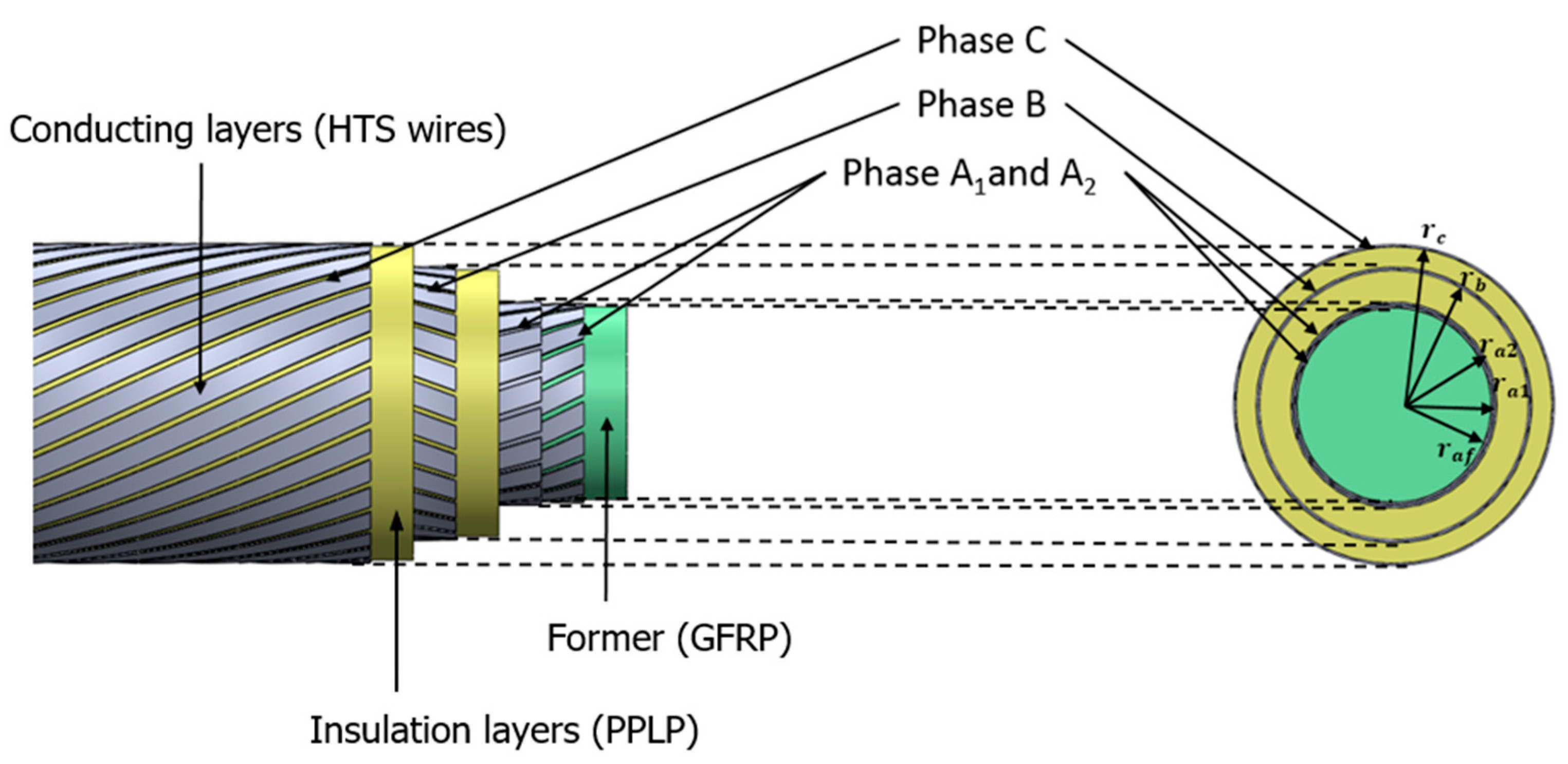
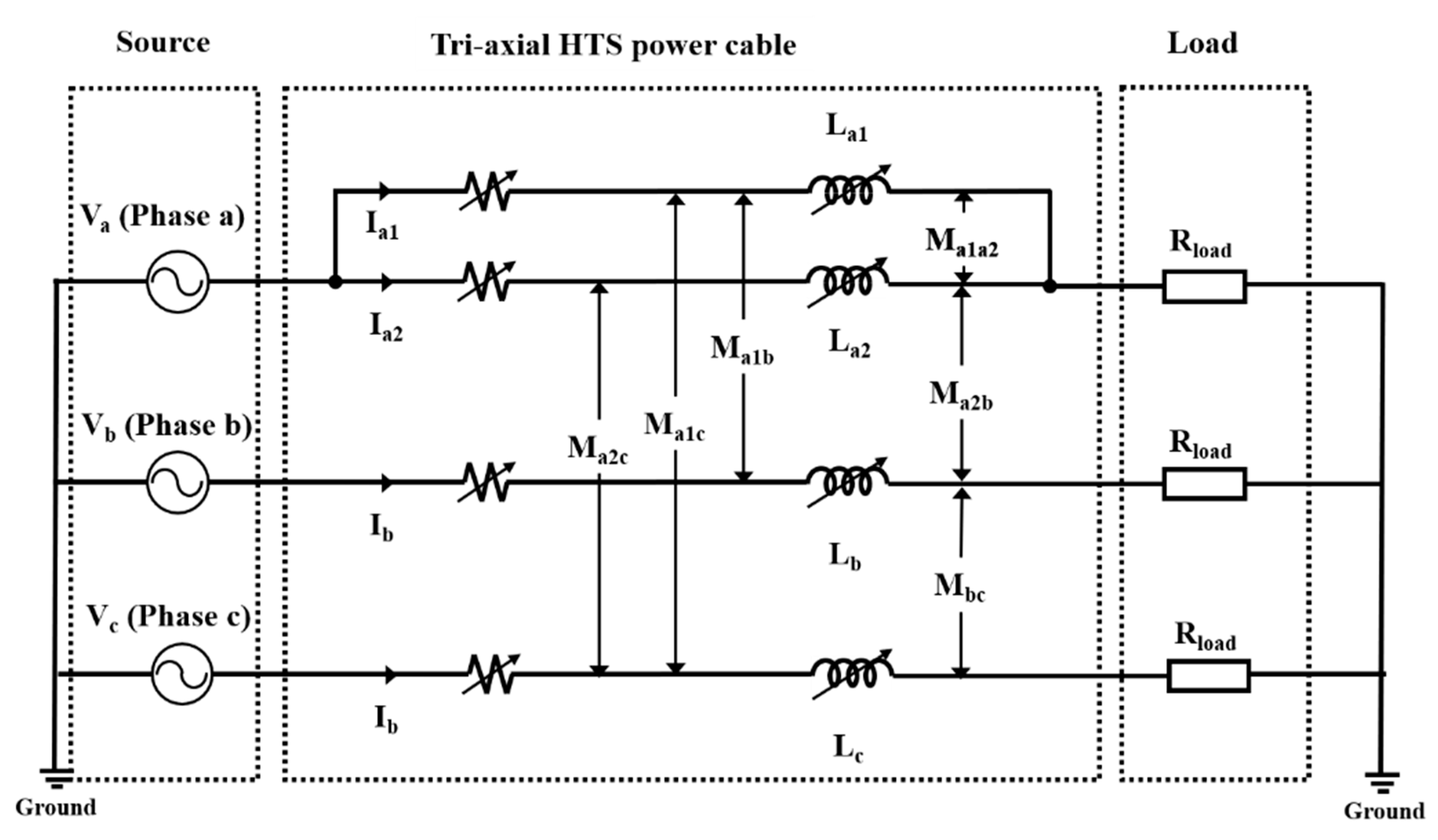

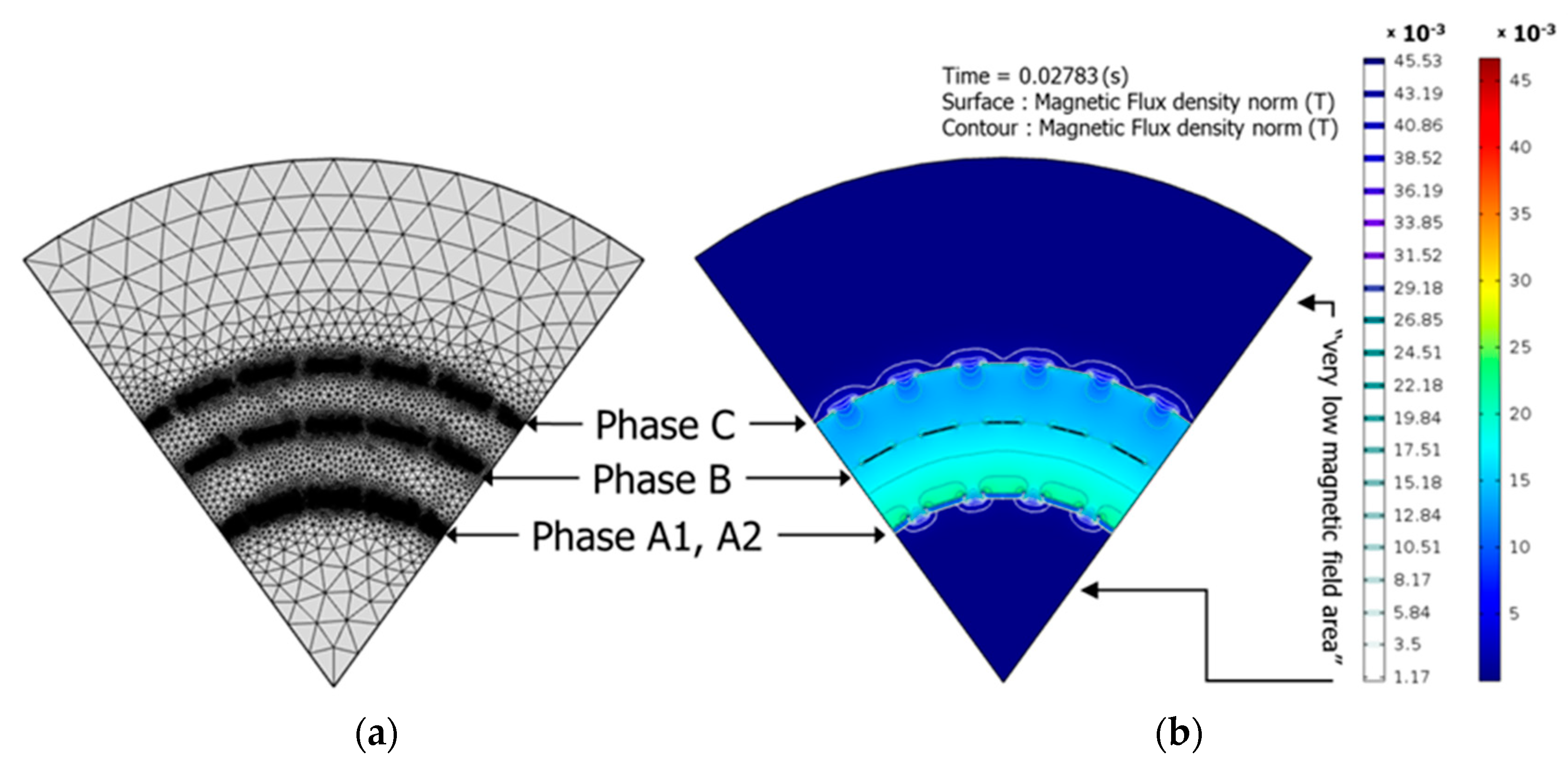

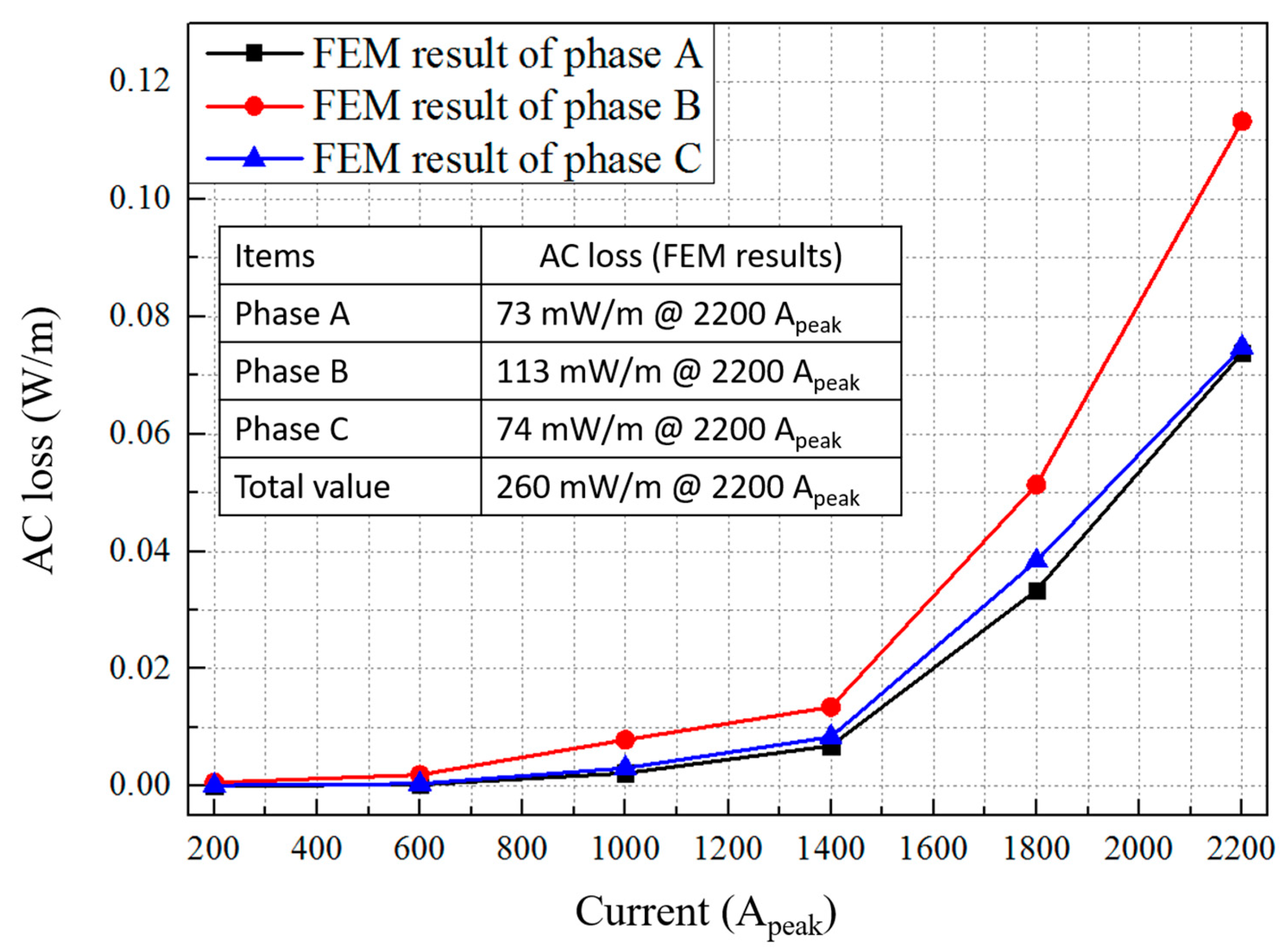
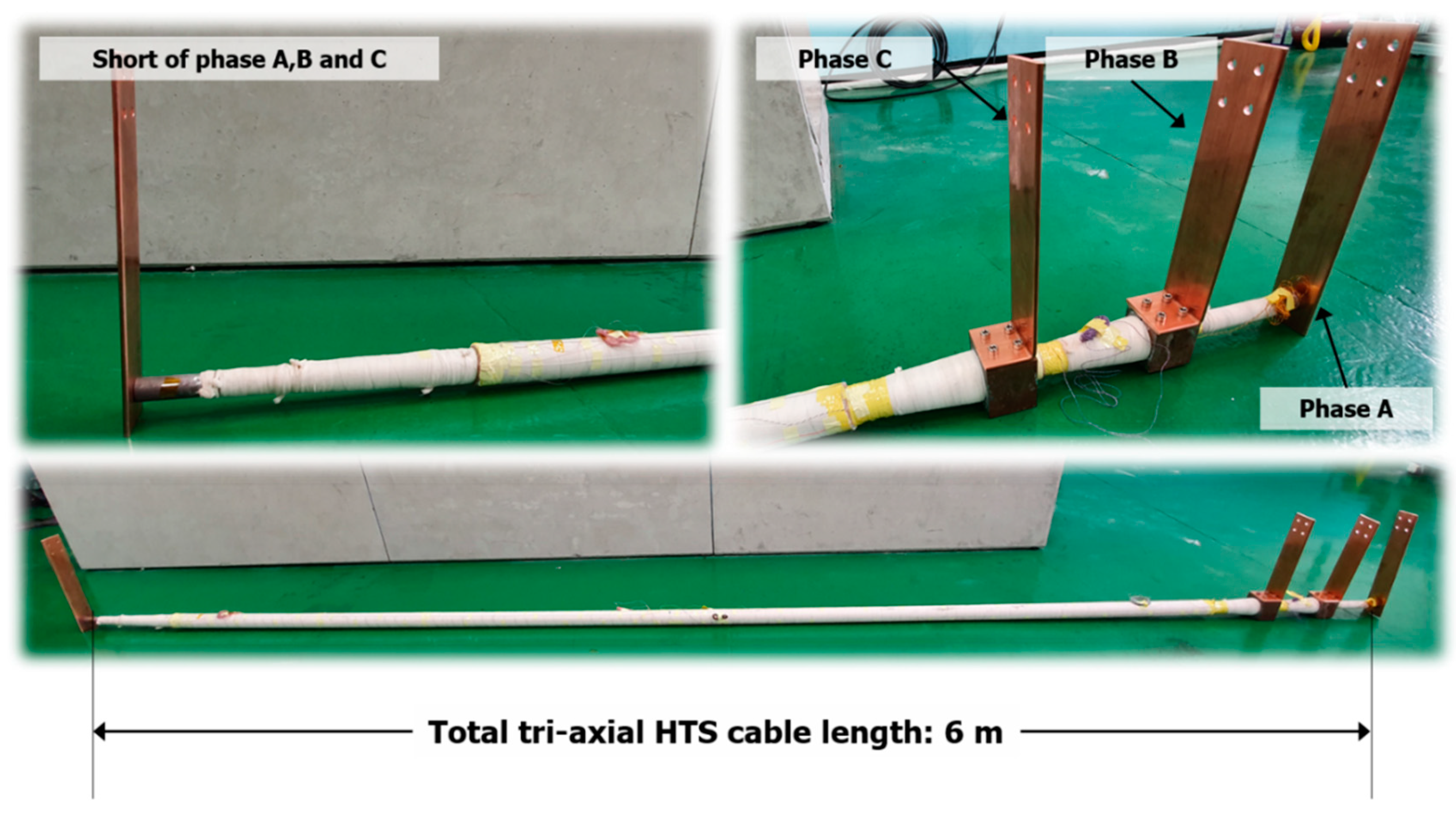
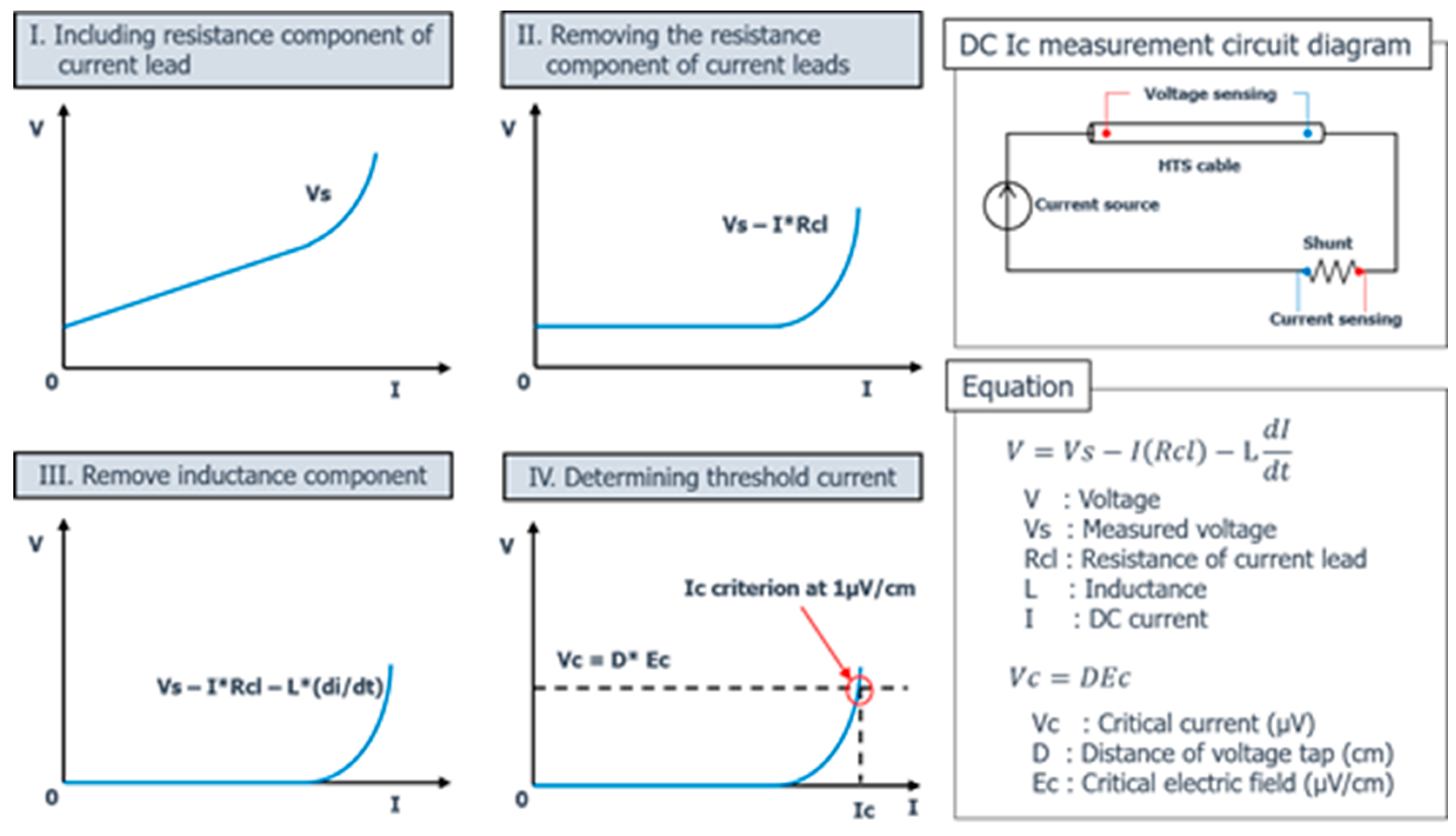
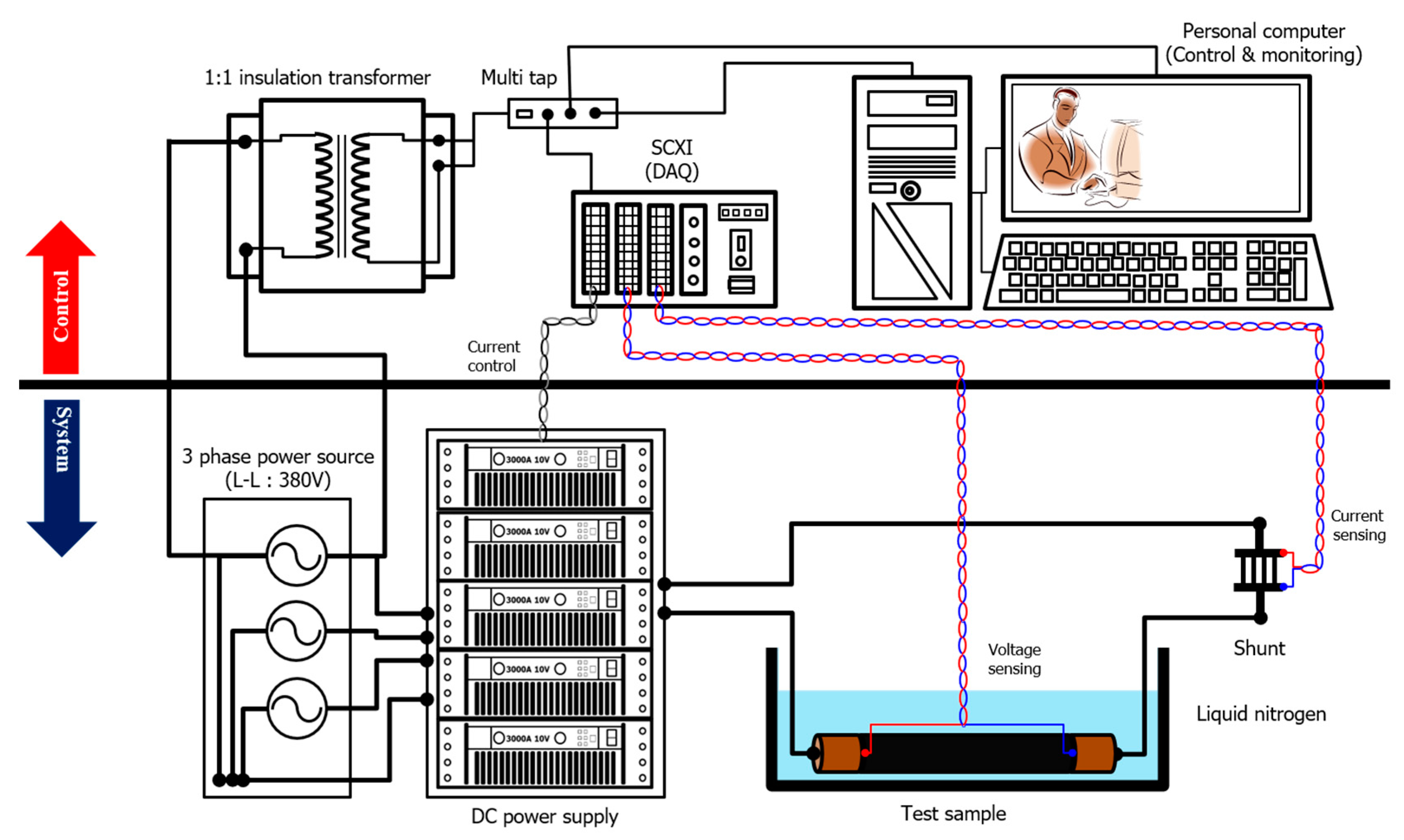


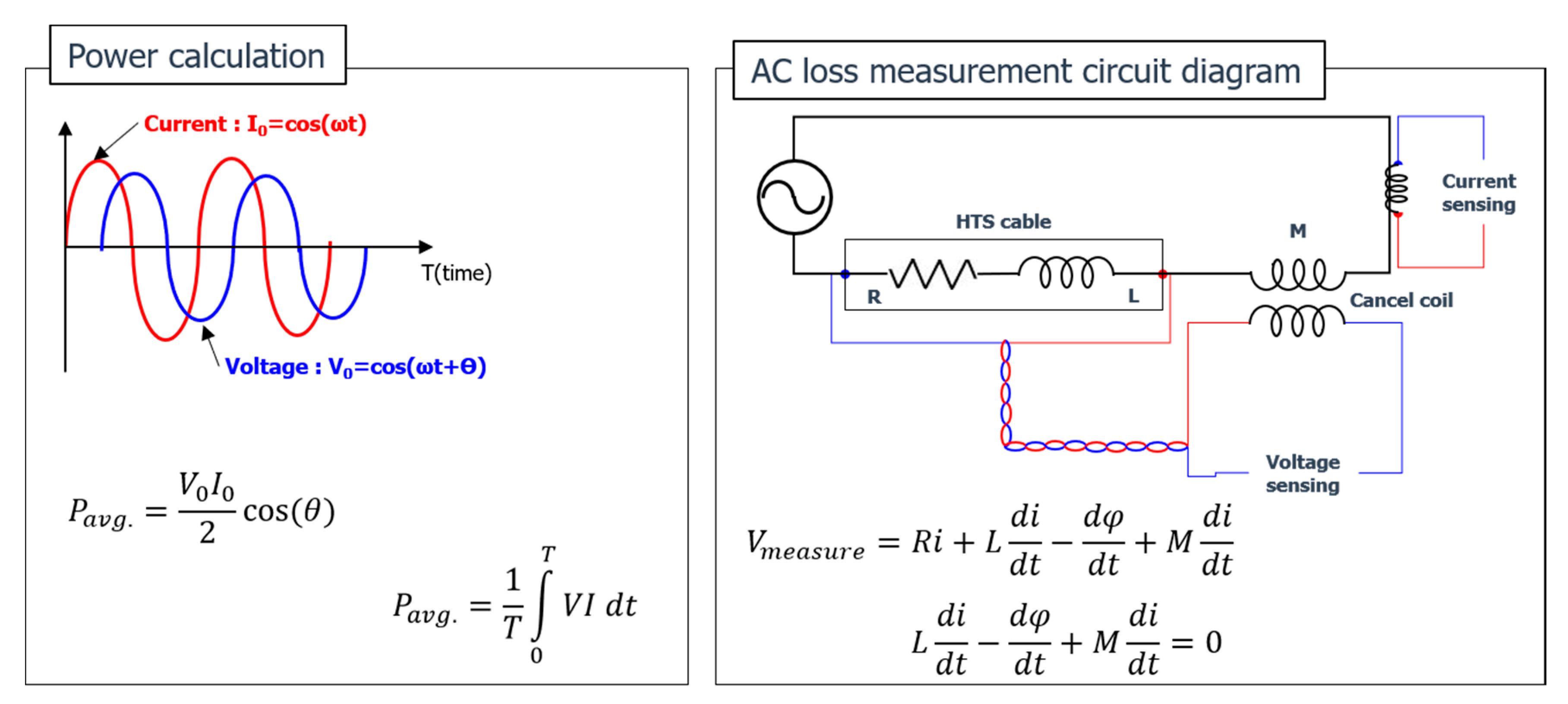


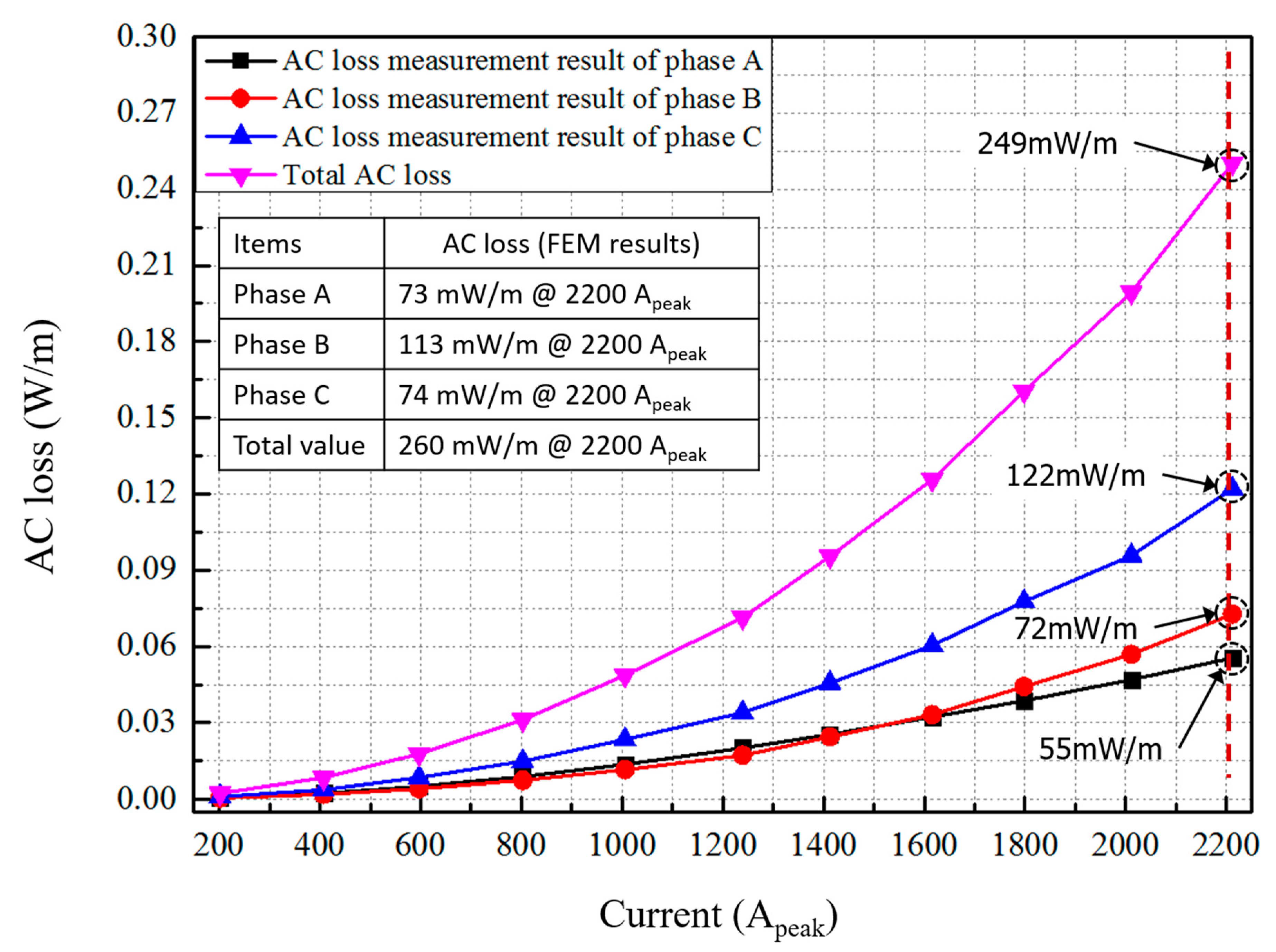
| Structure | Material | Values |
|---|---|---|
| Former | GFRP (Glass Fiber Reinforced Plastics) | Radius: about 16 mm |
| Conducting layers (phase A, B, C) | 2G HTS wire (S * Corp.) (to lamination) | Width 4 ~ 4.2 mm Thickness 0.2 ~ 0.25 mm Min. DC Ic: 150 A@77 K (self-field) |
| Insulation layers | PPLP (Poly-Propylene Laminated Paper) | Thickness: about 4~4.2 mm |
| Items | Values |
|---|---|
| Voltage/capacity | 23 kV/60 MVA |
| Rated current per phase | About 1500 Arms * (2200 Apeak *) |
| Total cable length | 6000 mm |
| Radius of each layer (phase A1/A2/B/C) | 18.2 mm/18.4 mm/24.5 mm/29.1 mm |
| Design temperature | 77.3 K (in liquid nitrogen) |
| Minimum DC Ic of each phases (phase A1/A2/B/C) | About 2900A/3100 A/4000 A/4500 A |
| Items | Values |
|---|---|
| Circuit condition | Load (about 8 Ω) |
| Pitch length of each layer (phase A1, phase A2, phase B, phase C) | 300/460/550/510 mm |
| Winding direction of each layer (+1 = clockwise, −1 = counter-clockwise) | +1,+1,−1,+1 |
| Current distribution of phase A1 | 1122.4 Apeak |
| Current distribution of phase A2 | 1030.7 Apeak |
| Current distribution of phase B | 2150.7 Apeak |
| Current distribution of phase C | 2150.8 Apeak |
| Current ratio between phase A1 and A2 | 0.9 |
© 2020 by the authors. Licensee MDPI, Basel, Switzerland. This article is an open access article distributed under the terms and conditions of the Creative Commons Attribution (CC BY) license (http://creativecommons.org/licenses/by/4.0/).
Share and Cite
Lee, S.-J.; Kang, S.Y.; Park, M.; Won, D.; Yoo, J.; Yang, H.S. Performance Analysis of Real-Scale 23 kV/60 MVA Class Tri-Axial HTS Power Cable for Real-Grid Application in Korea. Energies 2020, 13, 2053. https://doi.org/10.3390/en13082053
Lee S-J, Kang SY, Park M, Won D, Yoo J, Yang HS. Performance Analysis of Real-Scale 23 kV/60 MVA Class Tri-Axial HTS Power Cable for Real-Grid Application in Korea. Energies. 2020; 13(8):2053. https://doi.org/10.3390/en13082053
Chicago/Turabian StyleLee, Seok-Ju, Seong Yeol Kang, Minwon Park, DuYean Won, Jaeun Yoo, and Hyung Suk Yang. 2020. "Performance Analysis of Real-Scale 23 kV/60 MVA Class Tri-Axial HTS Power Cable for Real-Grid Application in Korea" Energies 13, no. 8: 2053. https://doi.org/10.3390/en13082053
APA StyleLee, S.-J., Kang, S. Y., Park, M., Won, D., Yoo, J., & Yang, H. S. (2020). Performance Analysis of Real-Scale 23 kV/60 MVA Class Tri-Axial HTS Power Cable for Real-Grid Application in Korea. Energies, 13(8), 2053. https://doi.org/10.3390/en13082053





